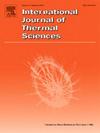局部热障涂层气膜冷却涡轮叶片换热特性研究
IF 4.9
2区 工程技术
Q1 ENGINEERING, MECHANICAL
International Journal of Thermal Sciences
Pub Date : 2025-04-09
DOI:10.1016/j.ijthermalsci.2025.109926
引用次数: 0
摘要
随着汽轮机进口温度的升高,热障涂层已成为一种有效的热防护技术。本地化TBC在解决局部过热问题方面优于传统的均匀TBC,还可以降低叶片的制造成本。气膜冷却涡轮叶片结构复杂,这给具有局部TBC的叶片数值模拟带来了挑战。本文采用多物理场耦合数值模拟和实验研究方法,分析了局部TBC对气膜冷却涡轮叶片的隔热效果。建立了具有局部TBC的气膜冷却叶片的高保真数值模拟模型,观察了局部TBC对气膜冷却叶片不同区域的影响。结果表明,在气膜冷却涡轮叶片的前缘、压力侧中部和尾缘处施加局部TBC具有较好的热保护效果。最大温度降低约为221 K。具体来说,前缘表面温度下降了约200 K,压力侧中部下降了150-200 K,压力侧尾缘下降了100-150 K,吸力侧尾缘下降了50-100 K。局部TBC不仅在发动机运行过程中提供了有效的隔热,而且在发动机关闭后显著减轻了叶片表面的突然温度波动。此外,本文采用的数值模拟方法与实验结果相比,计算误差小于15%,证实了模拟结果的准确性。本文章由计算机程序翻译,如有差异,请以英文原文为准。
Study on heat transfer characteristics of film cooling turbine vane with localized thermal barrier coating
With the increase in turbine inlet temperature, thermal barrier coating (TBC) has become an effective thermal protection technology. Localized TBC outperforms conventional uniform TBC in addressing localized overheating and can also reduce the manufacturing cost of the vane. The film cooling turbine vane has a complex structure, which makes numerical simulations of the vane with localized TBC challenging. This study employs multiphysics-coupled numerical simulations and experimental investigations to analyze the thermal insulation effects of localized TBC on film cooling turbine vanes. A high-fidelity numerical simulation model of a film cooling vane with localized TBC is established, and the effects of localized TBC on different regions of the film cooling vane are observed. The results show that localized TBC applied to the leading edge, midsection of the pressure side, and trailing edge of the film cooling turbine vane exhibit better thermal protection. The maximum temperature reduction is approximately 221 K. Specifically, the surface temperature at the leading edge decreases by approximately 200 K, at the midsection of the pressure side by 150–200 K, at the trailing edge of the pressure side by 100–150 K, and at the trailing edge of the suction side by 50–100 K. The localized TBC not only provides effective thermal insulation during engine operation but also significantly mitigates the sudden temperature fluctuations on the vane surface after engine shutdown. Furthermore, the numerical simulation method used in this paper shows a calculation error of less than 15 % compared with experimental results, confirming the accuracy of the simulation results.
求助全文
通过发布文献求助,成功后即可免费获取论文全文。
去求助
来源期刊

International Journal of Thermal Sciences
工程技术-工程:机械
CiteScore
8.10
自引率
11.10%
发文量
531
审稿时长
55 days
期刊介绍:
The International Journal of Thermal Sciences is a journal devoted to the publication of fundamental studies on the physics of transfer processes in general, with an emphasis on thermal aspects and also applied research on various processes, energy systems and the environment. Articles are published in English and French, and are subject to peer review.
The fundamental subjects considered within the scope of the journal are:
* Heat and relevant mass transfer at all scales (nano, micro and macro) and in all types of material (heterogeneous, composites, biological,...) and fluid flow
* Forced, natural or mixed convection in reactive or non-reactive media
* Single or multi–phase fluid flow with or without phase change
* Near–and far–field radiative heat transfer
* Combined modes of heat transfer in complex systems (for example, plasmas, biological, geological,...)
* Multiscale modelling
The applied research topics include:
* Heat exchangers, heat pipes, cooling processes
* Transport phenomena taking place in industrial processes (chemical, food and agricultural, metallurgical, space and aeronautical, automobile industries)
* Nano–and micro–technology for energy, space, biosystems and devices
* Heat transport analysis in advanced systems
* Impact of energy–related processes on environment, and emerging energy systems
The study of thermophysical properties of materials and fluids, thermal measurement techniques, inverse methods, and the developments of experimental methods are within the scope of the International Journal of Thermal Sciences which also covers the modelling, and numerical methods applied to thermal transfer.
 求助内容:
求助内容: 应助结果提醒方式:
应助结果提醒方式:


